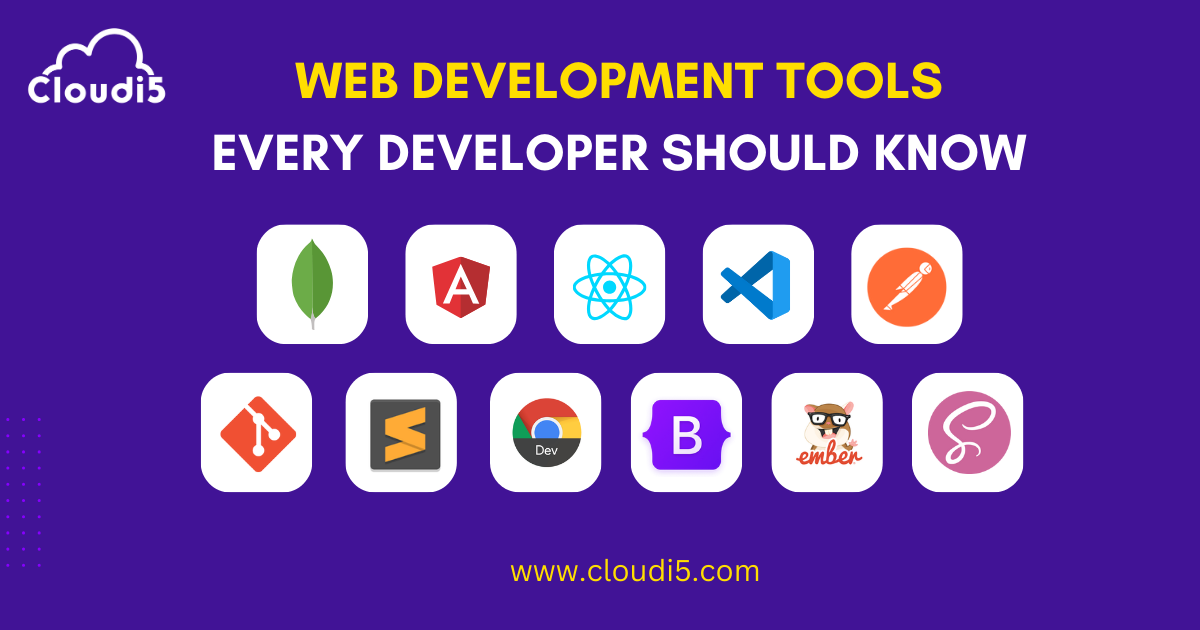
Tools For Web Development That All Developers Should Know
In the fast-paced world of web development, the correct web development tools can turn simple ideas into fascinating digital experiences. The arsenal of tools accessible to developers is extensive and indispensable, from simplifying code to improving user interfaces. Join me on a trip through the important tools that web developers rely on to create immersive, functional, and innovative online environments. Whether you're a seasoned coder or just starting out, these tools will serve as your compass, guiding you through the complex world of web development.
The below tools are used in web development trends.
1. Visual Studio code:
Microsoft's Visual Studio Code (VS Code) is a sophisticated and generally praised source code editor. It has been a favourite among developers of all disciplines due to its lightweight yet strong nature. VS Code supports an incredible number of programming languages and provides an intuitive interface favourable to efficient coding, among other things. Its rich extension marketplace allows users to customize their settings with a wide range of plugins, allowing for easy connection with version control systems, debugging tools, and language support upgrades. Aside from its main functions, its built-in terminal, intelligent code completion, and debugging tools greatly simplify the development workflow. Visual Studio Code, which has a customizable style and an ecosystem that fosters community-driven innovation.
2. Git:
Git, a distributed version control system, transformed collaborative software development by providing a robust and fast way to track code changes. Git's decentralized structure, designed by Linus Torvalds, enables developers to work offline, create distinct branches for experiments, and merge changes seamlessly. Its primary capability is the capacity to capture and manage different versions of files, allowing teams to collaborate across geographical borders.
Git's snapshot-based solution records the complete project history, assuring code management reliability and integrity. Parallel work is possible because of branching and merging capabilities that do not jeopardize the main codebase's stability. Furthermore, platforms such as GitHub and Bitbucket have leveraged Git's features by offering hosting, issue tracking, and code review tools, establishing a rich ecosystem for open-source collaboration.
3. Bootstrap:
Twitter's open-source front-end framework, Bootstrap, has emerged as a critical tool for developing adaptable and mobile-first websites and web applications. Bootstrap, known for its ease of use and wide set of pre-built components, makes it easier to create sleek, consistent, and visually appealing interfaces.
Bootstrap enables developers to create responsive layouts quickly by providing a grid system, responsive breakpoints, and a plethora of UI components such as navigation bars, buttons, forms, and carousels.
Its extensive customization possibilities via CSS and JavaScript extensions allow developers to tweak looks while remaining mobile-friendly. The documentation and community support provided by Bootstrap contribute to its success by giving direction and resources to developers of all skill levels. It is flexible to different devices and screen sizes.
4. Chrome Developer Tools:
Chrome Developer Tools is a must-have set of web development and debugging tools that is built into the Google Chrome browser. This feature-rich package of utilities provides a complete array of features to assist developers in generating, evaluating, and debugging web pages. Chrome Developer Tools provides a plethora of resources for fine-tuning web apps, from inspecting and changing HTML, CSS, and JavaScript in real time to evaluating and improving website performance. Its elements panel enables for precise analysis of page elements, styles, and layout, while the console aids with JavaScript debugging and command execution.
Performance monitoring tools aid in the identification of bottlenecks, the optimization of loading times, and the general responsiveness of the site. Furthermore, the Network panel enables developers to optimize site speed and efficiency by doing in-depth monitoring of network activity, resource loading, and requests. Chrome Developer Tools, with its simple UI and frequent upgrades, remains an indispensable tool for developers looking to create solid, high-performance web experiences.
5. React:
React, a Facebook-developed open-source JavaScript toolkit has become a cornerstone in modern web development for creating dynamic and interactive user interfaces. React, known for its component-based architecture and declarative programming style, makes it easier to create reusable UI components. Its virtual DOM maintains changes in an efficient manner, ensuring optimal rendering performance by minimizing actual DOM actions. React's use of JSX (JavaScript XML) allows developers to construct UI components with a syntax similar to HTML, improving readability and maintainability.
React's unidirectional data flow promotes predictable behaviour, making complex applications easier to manage and debug. Furthermore, React's ecosystem includes tools such as React Router for navigation management and Redux for state management, providing a comprehensive solution for developing scalable and efficient web apps. React remains a popular choice among developers for creating modern, responsive, and highly interactive web experiences due to its strong community support, thorough documentation, and emphasis on performance.
6. Postman:
Postman, a sophisticated API development communication platform, has become a must-have tool for developers, testers, and DevOps professionals. Postman, known for its user-friendly UI and extensive feature set, simplifies the process of designing, testing, and troubleshooting APIs. Its user-friendly interface allows users to create requests, group them into collections, and configure automated testing workflows. Postman's extensive suite of tools makes API discovery easier by allowing users to simply send various types of requests (GET, POST, PUT, DELETE, and so on), handle authentication, and check answers.
Furthermore, it allows users to create automated testing for API endpoints by allowing them to write test scripts in JavaScript. Postman accelerates the development lifecycle and enables the establishment of solid, well-tested APIs through its ability to share collections, communicate in real-time, and efficiently document APIs, making it an invaluable element in the API development process.
7. Ember.js:
Ember.js is a powerful, opinionated, and open-source JavaScript framework that excels at building ambitious online applications. Ember.js, known for its convention-over-configuration approach, simplifies development by providing a disciplined design and a set of best practices. Handlebars, its sophisticated templating engine, simplifies UI development by letting developers design templates that update dynamically when underlying data changes. Ember's heavy emphasis on convention promotes project uniformity, increasing productivity and maintainability.
Furthermore, Ember Data, the framework's data management module, allows for a smooth connection with backend services via adapters and serializers, making data retrieval and manipulation easier. Ember.js is a solid choice for building scalable, feature-rich web apps while emphasizing developer efficiency and application performance, thanks to a strong environment, extensive documentation, and an active community.
8. Sublime Text:
Sublime Text is a versatile and lightning-fast text editor that is popular among developers due to its speed, simplicity, and rich customization options. Its basic yet feature-rich interface supports a variety of programming languages and different plugins and packages that improve functionality. Sublime Text includes advanced editing tools such as multiple selections, split editing, and a command palette, which increases productivity by allowing users to swiftly execute commands and access functions.
Its distraction-free mode and handy keyboard shortcuts help to make coding a breeze. Furthermore, Sublime Text's performance remains outstanding, easily handling big files and projects while providing a smooth and responsive interface. Sublime Text, with its strong ecosystem of community-developed plugins and customizations, remains a top choice for developers looking for a quick, flexible, and highly customizable text editor for their coding pursuits.
9. Sass:
Sass (Syntactically Awesome Style Sheets) is a popular and sophisticated preprocessor scripting language that enhances CSS with capabilities like variables, nesting, mixins, and functions. Sass, as a CSS extension, provides a more structured and efficient approach to developing stylesheets, making CSS code more maintainable and reusable. Its use of variables enables easy reusability of values across stylesheets, minimizing redundancy and allowing for rapid global style changes.
Nesting organizes and visualizes the CSS structure, making the link between items easier to understand. Furthermore, mixins and functions allow for the construction of reusable blocks of styles as well as more dynamic and adaptive style definitions. The ability of Sass to compile into standard CSS maintains browser compatibility while also providing a more developer-friendly and efficient approach to design styles for modern online applications and websites.
10. Angular:
Google's Angular, a comprehensive TypeScript-based front-end web application framework, is a solid and extensively used platform for developing dynamic single-page applications (SPAs) and complicated online interfaces. Angular is well-known for its modular and component-based architecture, which makes it easier to develop scalable apps by dividing them down into smaller, reusable components, boosting code maintainability and reusability. Its two-way data binding and extensive templating capabilities make synchronization between the model and view simple, resulting in a consistent user experience.
The dependency injection architecture and services provided by Angular enable efficient data management, allowing components to communicate and share data in real-time. Furthermore, its powerful CLI (Command Line Interface) simplifies project creation, development, testing, and deployment. With a large ecosystem of libraries, strong community support, regular updates, and adherence to best practices, Angular remains a popular choice among developers looking to build sophisticated and feature-rich online apps.
Conclusion:
Mastering the correct tools can be the catalyst for success in the continually developing field of web development. Understanding the functionality of these web development tools isn't enough; you also need to know how to use them effectively to create amazing web experiences. The path to being a competent developer is not only understanding the tools but also knowing when and how to use them. So, let's keep exploring, experimenting, and harnessing the potential of these technologies in order to stimulate innovation and excellence in the field of web development.
Trusted By












Leave Comments